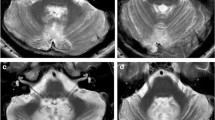Abstract
Neuropsychiatric symptoms, including mania and psychosis, have been reported with new or recent pediatric brain tumor diagnoses. However, such symptoms have rarely been described in the setting of stable postoperative posterior fossa lesions. The cerebellar cognitive affective syndrome, described more commonly in adults than children, suggests an association between the posterior fossa and affective dysregulation and cognition.
Here we describe a unique case of a 15-year-old male with no family history of psychiatric illness and stable postoperative posterior fossa tumor, who presented with florid psychosis that ultimately responded to lithium. This case of bipolar I disorder with psychotic features, in the framework of the literature to date, implicates the potential influence of the cerebellum and posterior fossa in limbic circuitry. This further emphasizes the value of future studies focused on the role of the posterior fossa in pediatric neuropsychiatry.
Access this chapter
Tax calculation will be finalised at checkout
Purchases are for personal use only
Similar content being viewed by others
References
Schmahmann J. Disorders of the cerebellum: ataxia, dysmetria of thought, and the cerebellar cognitive affective syndrome. Neuropsychol Pract Opin. 2004;16:367–78. https://doi.org/10.1176/jnp.16.3.367.
Siegel M, Beresford C, Bunker M, et al. Preliminary investigation of Lithium for mood disorder symptoms in children and adolescents with autism spectrum disorder. J Child Adolesc Psychopharmacol. 2014;24(7):399–402. https://doi.org/10.1089/cap.2014.019.
Jamieson R, Wells C. Manic psychosis in a patient with multiple metastatic brain tumors. J Clin Psychiatry. 1979;40(6):280–3.
Lassaletta A, Bouffet E, Mabbott D, Kulkarni A. Functional and neuropsychological late outcomes in posterior fossa tumors in children. Childs Nerv Syst. 2015;31(10):1877–90. https://doi.org/10.1007/s00381-015-2829-9.
Hanzlik E, Woodrome S, Abdel-Baki M, Geller T, Elbabaa S. A systematic review of neuropsychological outcomes following posterior fossa tumor surgery in children. Childs Nerv Syst. 2015;31(10):1869–75. https://doi.org/10.1007/s00381-015-2867-3.
Andrews JP, Taylor J, Saunders D, Qayyum Z. Peduncular psychosis. BMJ Case Rep. 2016; https://doi.org/10.1136/bcr-2016-216165.
Bommakanti K, Gaddamanugu P, Alladi S, Alladi S, Purohit A, Chadalawadi S, Mekala S, et al. Pre-operative and post-operative psychiatric manifestations in patients with supratentorial meningiomas. Clin Neurol Neurosurg. 2016;147:24–9. https://doi.org/10.1016/j.clineuro.2016.05.018.
Takahashi T, Nakamura K, Nishiyama S, Furuichi A, Ikeda E, Kido M, et al. Increased pituitary volume in subjects at risk for psychosis and patients with first-episode schizophrenia. Psychiatry Clin Neurosci. 2013;67(7):540–8. https://doi.org/10.1111/pcn.12093.
Schmahmann J. The neuropsychiatry of the cerebellum – insights from the clinic. Cerebellum. 2007;6:254–67. https://doi.org/10.1080/14734220701490995.
Schmahmann J. The role of the cerebellum in cognition and emotion: personal reflections since 1982 on the dysmetria of thought hypothesis, and its historical evolution from theory to therapy. Neuropsychol Rev. 2010;20(3):236–60. https://doi.org/10.1007/s11065-010-9142-x.
De Moura A, Pinaya W, Gadelha A, Zugman A, Noto C, Cordeiro Q, et al. Investigating brain structural patterns in first episode psychosis and schizophrenia using MRI and a machine learning approach. Psychiatry Res. 2018; https://doi.org/10.1016/j.pscychresns.2018.03.003.
Keser Z, Hasan K, Mwangi B, Gabr R, Steinberg J, Wilken J, et al. Limbic pathway correlates of cognitive impairment in multiple sclerosis. J Neuroimaging. 2017;27(1):37–42. https://doi.org/10.1111/jon.12381.
Hickey C, Sherman J, Goldenberg P, et al. Cerebellar cognitive affective syndrome: insights from Joubert syndrome. Cerebellum Ataxias. 2018;5:5. https://doi.org/10.1186/s40673-018-0085-y.
Author information
Authors and Affiliations
Corresponding author
Editor information
Editors and Affiliations
Rights and permissions
Copyright information
© 2019 Springer Nature Switzerland AG
About this chapter
Cite this chapter
Soe, K.C., Karlsson, C.D., Dunn, D.W. (2019). The Role of the Posterior Fossa in Pediatric Neuropsychiatry. In: Hauptman, A., Salpekar, J. (eds) Pediatric Neuropsychiatry. Springer, Cham. https://doi.org/10.1007/978-3-319-94998-7_5
Download citation
DOI: https://doi.org/10.1007/978-3-319-94998-7_5
Published:
Publisher Name: Springer, Cham
Print ISBN: 978-3-319-94997-0
Online ISBN: 978-3-319-94998-7
eBook Packages: MedicineMedicine (R0)




